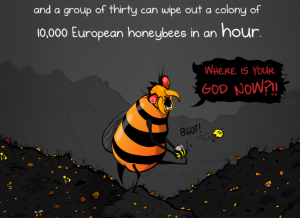So called ‘murder hornets’ have been in the news lately, after being discovered in Washington State. These Asian giant hornets are native to Asia, as one might expect. Besides their ability to deliver a painful, sometimes lethal sting to humans, they also pose a risk to honeybees. Murder hornets can decimate entire colonies of honeybees, Apis mellifera, by decapitating the bees. A New York Times article today has a video of a defense employed by honeybees in Japan, where the bees have evolved a way to protect themselves against the hornets. This defense involves forming a tight ball around the hornet and increasing the temperature – by heating up the wasps until they die.
This thermal defense is much like a fever, and is described in a variety of bee species against various wasps and other predators. European honeybees do not typically form a defensive bee ball, and are more likely to have their colony destroyed as a result. This thermal defense appears to be tailored to a history of predation by specific insect predators and is an example of an adaptation. The vulnerability of European honeybees may be explained in part as a gen-environment mismatch, since they have not been previously exposed to the Asian giant hornet.
Interestingly, the bee ball behavior comes at a cost. In a paper by Yamaguchi and colleagues, entitled ‘Double-edged heat: honeybee participation in a hot defensive bee ball reduces life expectancy‘, Japanese honeybees that participated in the bee ball had a shortened lifespan compared to those that do not. This highlights the fact that defenses have costs – but the defender gambles that the cost to the invader is greater than the cost to to the self (or to the colony); Ed LeGrand and I described that trade-off in our 2012 paper, Immune Brinksmanship.
Honeybees are able to generate defensive heat in other contexts. Colonies infected with the fungus that causes chalk brood are able to reduce larval killing by generating a what is described as “brood comb fever.” Vibration of the worker bee wings increases the temperature of that part of the colony in similar fashion to defensive bee balls that kill murder hornets.Interestingly, elevated temperature in honeybees may help defend them against viral infections; honeybees warmed to 42 degrees C had increased transcription of heat shock proteins and improved antiviral defense, and better survival.
Behavioral fever has been described in a variety of other arthropods, such as the Senegalese grasshopper. Fever as a strategy of defense has been observed across the tree of life. Mackiowack (2000) writes that “a febrile response has been documented in the phyla Vertebrata, Arthropoda, and Annelida. These observations suggest that the febrile response evolved more than 4 million years ago, at approximately the time when evolutionary lines leading to arthropods and annelids diverged.” The evolutionary conservation of fever, and its broad usefulness against predators large and small, are worth considering when we ask the question, what should we do with febrile patients with presumed viral infections in the clinic, emergency department and ICU?
Update: TheOatmeal.com has a great entry about this. Click below:
 Comic by Matthew Inman from TheOatmeal.com
Comic by Matthew Inman from TheOatmeal.com
Categories: Uncategorized
Joe Alcock
Emergency Physician, Educator, Researcher, interested in the microbiome, evolution, and medicine


Dr. Alcock,
I remember that you said the class will discuss the influence of the gut microbiome on sepsis in the coming weeks; I look forward to that discussion. I don’t remember if I have sent you the dietary fiber paper we did for the pet food business, so I attached it for your review. We have learned how to predict what we call a [fermentation load] which feeds the gut microbiome. The fermentation load entails dietary fiber components of course but also many other components including N and protein. Once the basic fermentation load has been determined and balanced, prebiotic fibers can be added within this framework. Dietary fiber and protein interact and determine which organisms can flourish and of course produce metabolites. This understanding allows us to have a much greater predictability on fermentation and host outcomes; but, in addition, may explain—at least, in part–why vegetarian diets are so successful. I apologize if I have already sent this.
Fred Madsen, PhD Madsen Nutrition Services, Inc. Adding the Wonders of Plants to Balance the Animal World
>
We COULD train some birds to sight , smell, detect these nests.
Dogs could also, since most nests are ground….but dogs will need a professional suit as Humans designed.
Every nest found would be a bounty find, and provide insect food for chickens etc.